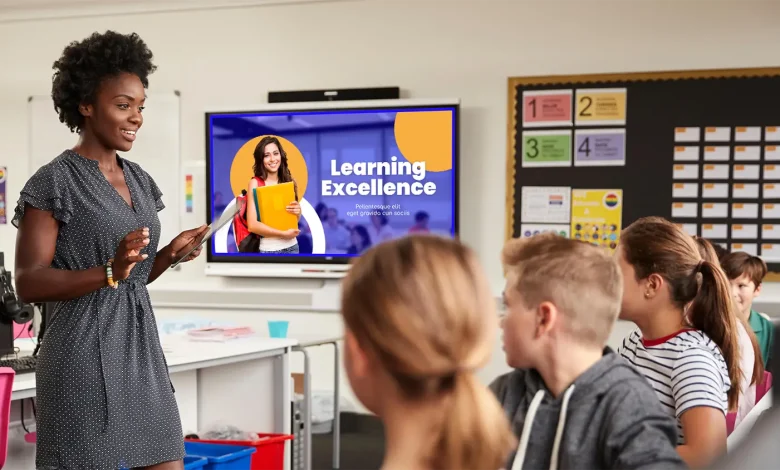Teaching Students Through Interactive Signage

In an era where technology permeates every aspect of life, the education sector is not left untouched. Classrooms are transforming, and traditional teaching methods are being supplemented with innovative tools designed to stimulate and engage students. One such pioneering method is the use of digital signs in the classroom, an advancement that is revolutionizing how educators impart knowledge and how students absorb it. This article delves into ways in which digital signs can enhance the teaching and learning process, thereby increasing digital literacy among students.
The Role of Digital Signs in Modern Classrooms
Digital signage in educational settings is more than just a tool for displaying information. It is an interactive platform that can be used for a wide range of purposes, from showcasing student work to providing real-time updates on campus events. The dynamic nature of digital signs means they can capture the attention of students who are accustomed to digital devices, thereby offering a familiar medium through which instructional content can be conveyed.
Enhancing Interactivity
The interactive capabilities of digital signs lend themselves to a learning environment that promotes student engagement. Through touch screens and multimedia content, digital signs enable interactivity that encourages students to participate actively in their learning. Interactive signage can facilitate collaboration, group discussions, and workshops, making the learning process a more hands-on experience.
Customisable Learning
Every student has a unique learning style, and digital signs cater to this diversity. They allow educators to custom develop content that can target different learning preferences, be it visual, auditory, or kinesthetic. With the flexibility to switch between text, images, videos, and interactive elements, teachers can create a more inclusive learning environment that reaches every student.
Visually Stimulating
The high-quality visuals that are a hallmark of digital signage can be compelling for students, making lessons memorable and interesting. When information is presented in a visually engaging format, students are more likely to retain it. This can be particularly beneficial for subjects that require the assimilation of complex data or where visual learning aids can provide clarity.
Greater Access to Information
Digital signs are not limited to the confines of the classroom. Positioned in public spaces within schools, they can serve as bulletin boards, providing students with easy access to information about upcoming events, critical announcements, or educational materials. This constant exposure to information in a digital format is an excellent practice in sifting through and comprehending digital content.
Real-Time Updates and Alerts
One of the strengths of digital signage is the capacity for real-time communication. This is particularly useful for sharing important announcements, such as safety alerts or schedule changes, swiftly and effectively with the entire student body. Moreover, it familiarizes students with the concept of live data feeds, an increasingly common feature in the digital world.
Supporting Environmental Initiatives
Schools conscious of their environmental impact can use digital signs to reduce paper waste. Instead of printing flyers and notices, information can be disseminated digitally, fostering a culture of sustainability among students. This teaches them about environmental stewardship and responsible digital practices.
Educational Continuity
In unforeseen circumstances, such as those requiring remote learning, digital signs can play a pivotal role. They can be used to communicate with students, ensuring that education continues unhindered regardless of physical location. By maintaining a digital connection with students, schools underscore the importance of digital literacy in accessing education.
Encouraging Responsibility
Involving students in the management and content creation for digital signage can nurture a sense of responsibility and ownership. These opportunities can teach students valuable skills in digital content management, design, and communication, all of which are critical in a digital-focused future.
Facilitating Feedback
Interactive digital signs can be utilised to gather instant feedback from students on lessons or campus services. This instant communication line encourages students to voice their opinion, and also teaches them the importance of providing feedback through digital channels.
Preparing for the Future
The use of digital signs equips students with the skills needed to navigate the digital landscape beyond the classroom walls. With digital literacy becoming a fundamental skill in the workforce, exposure to such technologies prepares students for future academic endeavors and employment opportunities.
Conclusion
Digital signs are more than just an educational trend; they are a potent tool for enhancing learning, increasing student engagement, and nurturing digital literacy. They can transform classrooms into interactive learning environments that prepare students for a digital future. As educational institutions continue to embrace technology, the intelligent integration of digital signage into the learning experience is imperative for fostering digitally literate generations. To explore how digital signs can transform your classroom or educational institution, visit Digital School Signs for more information and guidance.
Embracing Digital Evolution
As digital literacy becomes a cornerstone of education, schools must adapt to encompass these technological advancements. Incorporating digital signage into classroom teaching exemplifies the commitment to evolving educational practices. By doing so, educators can provide their students with the skills and knowledge to thrive in a digitally interconnected




